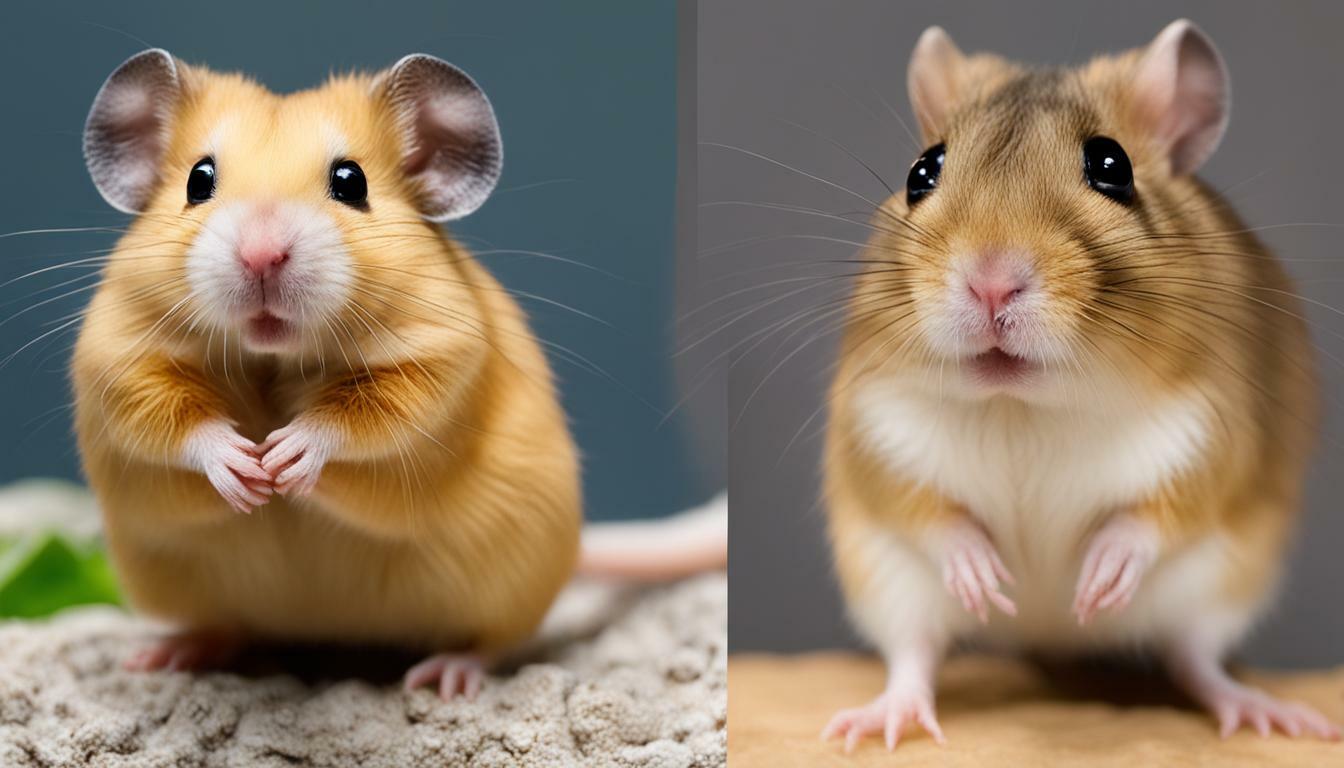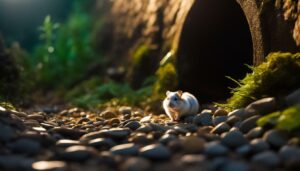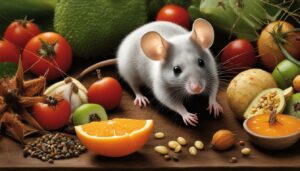Hamsters and gerbils are both popular small pet choices, but they have distinct differences in terms of their physical traits, behavior, and care needs.
Key Takeaways:
- Hamsters have short, stubby tails, while gerbils have longer tails that are roughly the length of their bodies.
- Hamsters have short, stocky legs and a rounder, wider face, while gerbils have longer legs and a more lean face.
- Gerbils are known for their curiosity and energy, while hamsters tend to be more laid-back and are nocturnal.
- Gerbils are more social creatures and do well in pairs or groups, while hamsters are generally solitary and territorial.
- Hamsters have cheek pouches for storing food, while gerbils do not.
- Both hamsters and gerbils come in a variety of colors.
- Guinea pigs are larger than both hamsters and gerbils and are herbivores, while hamsters and gerbils are omnivores.
Now that you know the key differences between hamsters and gerbils, you can make an informed decision about which small pet is the best fit for you and your lifestyle.
Physical Characteristics
One of the main physical differences between hamsters and gerbils is their tail length, with hamsters having short, stubby tails and gerbils boasting longer tails that are roughly the length of their bodies. Hamsters also have shorter legs and a rounder, wider face, while gerbils have longer legs and a more lean face.
Gerbils are known for their agility and quick movements, which are facilitated by their longer legs. Their slender physique allows them to easily navigate their surroundings and explore their habitat. In contrast, hamsters have a more stocky build, giving them a slightly different appearance.
Both hamsters and gerbils come in a variety of colors. From the classic golden hamster to the striking black gerbil, owners have a wide range of options to choose from when it comes to the coloration of their small pets. These colors add to the aesthetic appeal of these adorable creatures and make them even more delightful to look at.
Summary:
- Hamsters have short, stubby tails, while gerbils have longer tails that are roughly the length of their bodies.
- Hamsters have shorter legs and a rounder, wider face, while gerbils have longer legs and a more lean face.
- Both hamsters and gerbils come in a variety of colors, adding to their visual appeal.
| Hamsters | Gerbils | |
|---|---|---|
| Tail Length | Short and stubby | Long, roughly the length of their bodies |
| Leg Structure | Short and stocky | Long and slender |
| Face Shape | Rounder and wider | Leaner |
Behavior and Social Preferences
When it comes to behavior and social preferences, gerbils are known for their high levels of curiosity and energy, while hamsters tend to be more relaxed and prefer to live solitary lives. Gerbils thrive on interaction and enjoy exploring their surroundings, often engaging in playful activities such as digging and tunneling. They are social animals and do well when housed in pairs or small groups. Gerbils also have a strong sense of curiosity and will readily investigate new objects and environments.
On the other hand, hamsters are nocturnal creatures that prefer to be active during the night. They are more solitary in nature and have a tendency to exhibit territorial behavior. Hamsters are content with having their own space and do not require the constant companionship of other hamsters. Due to their solitary nature, it is important to provide hamsters with enough enrichment and stimulation to keep them mentally and physically engaged.
In terms of habitat preferences, gerbils require a larger living space with plenty of room for exploration and burrowing. They are highly active and need sufficient space to run, climb, and play. Hamsters, on the other hand, are less active and can thrive in smaller enclosures. However, regardless of the species, it is essential to provide a safe and secure habitat that meets their specific needs.
| Behavior and Social Preferences | Gerbils | Hamsters |
|---|---|---|
| Social Nature | Enjoy the company of other gerbils | Prefer solitary living |
| Activity Level | Highly active and curious | Nocturnal and more relaxed |
| Habitat Requirements | Need larger space for exploration and burrowing | Can thrive in smaller enclosures |
Diet and Nutrition
The diet of hamsters and gerbils differs in terms of their nutritional needs and preferences, with both species being omnivores. It is important to provide a balanced diet that meets their specific requirements to ensure their health and well-being.
Hamsters require a diet that consists of a mix of commercial hamster pellets, fresh fruits and vegetables, and occasional protein sources such as mealworms or boiled eggs. They are known to hoard food in their cheek pouches, so it’s essential to offer a variety of foods in small amounts throughout the day.
Gerbils, on the other hand, have a higher need for protein and require a mix of commercial gerbil pellets, fresh vegetables, and a moderate amount of fresh fruits. Additionally, they also need access to chew toys and blocks to maintain their dental health. It is important to avoid feeding gerbils foods that are fatty, sugary, or toxic to them, such as chocolate or onions.
Diet Comparison
| Hamsters | Gerbils |
|---|---|
| Omnivorous | Omnivorous |
| Commercial hamster pellets | Commercial gerbil pellets |
| Fresh fruits and vegetables | Moderate fresh fruits and vegetables |
| Occasional protein sources (mealworms, boiled eggs) | Higher need for protein |
| Food hoarding behavior | Chew toys and blocks for dental health |
| Avoid fatty, sugary, and toxic foods | Avoid fatty, sugary, and toxic foods |
Remember to always provide fresh, clean water in a suitable water bottle or dish for both hamsters and gerbils. It is important to monitor their dietary intake, adjust portion sizes accordingly, and consult with a veterinarian for specific dietary recommendations to ensure optimal nutrition for your small pets.
Lifespan and Care
Hamsters and gerbils have different lifespans and care requirements, which pet owners should consider when deciding which species is the best fit for their lifestyle. On average, hamsters live for about two to three years, while gerbils have a slightly longer lifespan of around three to four years. However, it’s important to note that individual lifespans can vary, and proper care and diet can greatly impact the longevity of both species.
In terms of care, both hamsters and gerbils require a clean and spacious cage with proper bedding and habitat enrichment. Providing a suitable environment that mimics their natural habitat is crucial for their overall well-being. Hamsters are more solitary animals and are content living alone, while gerbils are highly social creatures that thrive in pairs or small groups. If choosing to keep gerbils, it’s recommended to provide them with companionship to prevent loneliness and promote their social behaviors.
Diet plays an essential role in the health and longevity of hamsters and gerbils. Both species are omnivorous but have slightly different nutritional needs. A balanced diet for hamsters consists of a mix of pelleted food, fresh vegetables, and occasional fruits and treats. On the other hand, gerbils require a diet that is higher in protein, with a focus on seeds, grains, and fresh vegetables. It is important to provide fresh water daily and monitor their food intake to ensure they are getting the necessary nutrients.
Hamster Care Tips:
- Provide a spacious cage with proper bedding and habitat enrichment.
- Offer a mix of pelleted food, fresh vegetables, and occasional fruits and treats.
- Ensure they have access to fresh water at all times.
- Provide them with hiding spots and chew toys for mental stimulation.
- Monitor their activity levels and provide opportunities for exercise.
Gerbil Care Tips:
- Provide a spacious cage with proper bedding and habitat enrichment.
- Offer a diet that is high in protein, with a focus on seeds, grains, and fresh vegetables.
- Ensure they have access to fresh water at all times.
- Provide companionship by housing them in pairs or small groups.
- Offer plenty of toys and opportunities for play to keep them mentally stimulated.
By considering the lifespan and care requirements of hamsters and gerbils, pet owners can make an informed decision about which species is the best fit for their lifestyle. Whether you prefer the solitary nature of a hamster or the social dynamics of a gerbil, providing a loving and suitable environment is key to ensuring the health and happiness of these small furry companions.
| Hamsters | Gerbils | |
|---|---|---|
| Average Lifespan | 2-3 years | 3-4 years |
| Cage Requirements | Spacious with bedding and enrichment | Spacious with bedding and enrichment |
| Diet | Pelleted food, fresh vegetables, occasional fruits and treats | Seeds, grains, fresh vegetables |
| Social Behavior | Solitary | Social, thrive in pairs or small groups |
Color Variations
Hamsters and gerbils come in various colors, adding to their charm as pets. These small rodents display a wide range of coat colors and patterns, making them visually appealing to many pet owners. From solid hues like white, black, and brown, to more intricate patterns such as piebald and tortoiseshell, there is a color variation to suit every aesthetic preference.
Hamsters are known for their diverse coat colors, including golden, cinnamon, and pearl variations. They can also have unique markings, such as spots or stripes, further enhancing their overall appearance. Gerbils, on the other hand, often have a base color complemented by a darker stripe down their back. Common colors for gerbils include agouti, black, and sable.
| Hamster Colors | Gerbil Colors |
|---|---|
| Golden | Agouti |
| Cinnamon | Black |
| Pearl | Sable |
| White | |
| Black | |
| Brown | |
| Spotted | |
| Striped |
While color may not impact the care requirements or behavior of hamsters and gerbils, it does contribute to their overall uniqueness as pets. Whether you prefer a hamster with a golden coat or a gerbil with a striking black hue, the variety of colors available ensures that you can find a pet that matches your personal taste.
Additional Information About Guinea Pigs
It is worth mentioning that guinea pigs, unlike hamsters and gerbils, are larger in size and have distinct dietary requirements. Guinea pigs can grow to be around 8-12 inches long, making them significantly larger than both hamsters and gerbils. Due to their larger size, guinea pigs require more space and a larger cage to accommodate their size and provide them with ample room to roam and exercise.
When it comes to their diet, guinea pigs are strict herbivores. They rely on a diet of fresh hay, vegetables, and pellets specially formulated for their nutritional needs. Unlike hamsters and gerbils, guinea pigs do not have the ability to produce vitamin C on their own. Therefore, it is crucial to supplement their diet with vitamin C-rich fruits and vegetables to prevent deficiencies and associated health problems.
In terms of compatibility with other pets, guinea pigs are generally gentle and sociable creatures that can get along well with other guinea pigs. However, they may not be as compatible with hamsters or gerbils due to their size difference and different social needs. It is important to supervise interactions between different species to prevent any aggressive behavior or potential harm.
| Characteristics | Hamsters | Gerbils | Guinea Pigs |
|---|---|---|---|
| Tail Length | Short and stubby | Long, roughly the length of their bodies | No tail |
| Leg Structure | Short and stocky | Long and slender | Short legs |
| Facial Features | Rounded, wider face | Lean face | Rounded face |
| Behavior | More laid-back, nocturnal | Energetic, curious | Gentle, sociable |
| Socialization | Solitary, territorial | Do well in pairs or groups | Do well in pairs or groups |
| Cheek Pouches | Have cheek pouches for storing food | No cheek pouches | No cheek pouches |
Exploring Hamster and Gerbil Ownership
Owning hamsters or gerbils can be a rewarding experience, but it is important to consider factors such as their care requirements and compatibility with other pets. When it comes to care, both hamsters and gerbils have specific needs that must be met to ensure their health and well-being. For instance, hamsters require a cage with appropriate bedding, regular exercise opportunities, and a balanced diet consisting of pellets, fresh vegetables, and occasional treats. Gerbils, on the other hand, need a larger cage with deep bedding for burrowing, as well as plenty of toys and opportunities for mental stimulation.
Another aspect to consider is the compatibility of hamsters and gerbils with other pets. While hamsters are generally solitary animals that prefer to live alone, some species of gerbils can be housed together in pairs or small groups. However, it is important to introduce gerbils to each other gradually and monitor their interactions to ensure they are getting along. Additionally, it is important to keep hamsters and gerbils away from cats, dogs, and other predatory animals to prevent any potential harm.
Summary of Care Requirements:
- Hamsters and gerbils have specific care requirements that must be met for their health and well-being.
- Hamsters need a cage with appropriate bedding, regular exercise opportunities, and a balanced diet.
- Gerbils require a larger cage with deep bedding for burrowing and plenty of toys for mental stimulation.
- Hamsters are generally solitary and prefer to live alone, while gerbils can be housed together in pairs or small groups.
- Introduce gerbils to each other gradually and monitor their interactions to ensure they are getting along.
- Keep hamsters and gerbils away from cats, dogs, and other predatory animals.
In conclusion, owning hamsters or gerbils can bring joy and companionship into your life. However, it is essential to provide them with the proper care, attention, and environment to thrive. By understanding their unique characteristics, behavior, and social preferences, you can create a happy and healthy home for your furry friends. Always remember to consult with a knowledgeable veterinarian and do your research before bringing a hamster or gerbil into your home.
| Hamsters | Gerbils |
|---|---|
| Short, stubby tails | Long tails roughly the length of their bodies |
| Short, stocky legs | Longer legs |
| Rounder, wider face | Leaner face |
| More laid-back and nocturnal | Curious, energetic, and diurnal |
| Solitary and territorial | Social and do well in pairs or groups |
| Cheek pouches for storing food | No cheek pouches |
Conclusion
In conclusion, hamsters and gerbils may both make delightful pets, but their differences in terms of physical traits, behavior, and care requirements are significant.
Physically, hamsters have short, stubby tails, while gerbils have longer tails that are roughly the length of their bodies. Hamsters also have short, stocky legs and a rounder, wider face, whereas gerbils have longer, leaner legs and a more angular face.
When it comes to behavior, gerbils are known for their curiosity and energy, making them highly active and inquisitive pets. They thrive in pairs or groups, as they are social creatures. On the other hand, hamsters are more laid-back and tend to be solitary and territorial, preferring to be the sole occupant of their habitat.
Regarding care requirements, hamsters have cheek pouches that allow them to store food for later consumption, whereas gerbils do not possess this feature. Both hamsters and gerbils come in a variety of colors, adding to their aesthetic appeal. It is worth noting that guinea pigs are larger than both hamsters and gerbils and have different dietary preferences, being herbivores.
Considering these differences, it is essential to carefully consider the traits and needs of hamsters and gerbils before selecting a pet. Whether you prefer a more active and social pet like a gerbil or a quieter and more independent companion like a hamster, providing the appropriate care and environment will ensure a happy and rewarding experience for both you and your small furry friend.
FAQ
What are the main physical differences between hamsters and gerbils?
Hamsters have short, stubby tails and stocky legs, while gerbils have longer tails roughly the length of their bodies and longer legs. Hamsters also have a rounder, wider face compared to the leaner face of gerbils.
How does the behavior of hamsters differ from gerbils?
Gerbils are known for their curiosity and energy, while hamsters tend to be more laid-back and are active mostly at night. Gerbils are more social creatures and do well in pairs or groups, while hamsters are generally solitary and territorial.
Are there any differences in the diet of hamsters and gerbils?
Both hamsters and gerbils are omnivores, but they may have slightly different nutritional needs and preferences. It is important to provide a balanced diet consisting of commercial pellets, fresh fruits and vegetables, and occasional treats for both species.
How long do hamsters and gerbils typically live, and what kind of care do they require?
Hamsters have an average lifespan of around 2-3 years, while gerbils can live up to 4-5 years with proper care. Both species require a suitable cage with bedding, fresh water, a balanced diet, regular exercise, and proper hygiene and grooming.
Do hamsters and gerbils come in different colors?
Yes, both hamsters and gerbils come in a variety of colors, including shades of grey, brown, black, white, and combinations of these colors.
How do guinea pigs differ from hamsters and gerbils?
Guinea pigs are larger than both hamsters and gerbils and are herbivores, meaning their diet consists mainly of fresh hay, vegetables, and vitamin C-rich foods. They have different care requirements and are not as commonly kept as pets as hamsters and gerbils.




